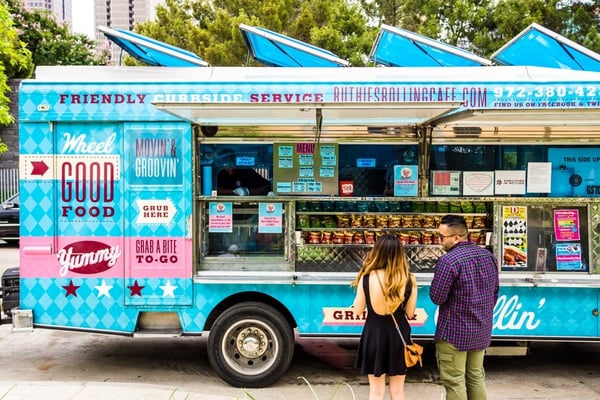
It’s likely you’ve seen them—food trucks of all flavors and fare parked in large mixed use commercial parking lots or outdoor recreation destinations. Preparing on-the-spot items ranging from gourmet sandwiches and vegan wraps to sushi, food trucks are drawing attention to retailers and restaurateurs for more than just the food they serve.
What you may not have suspected the last time you walked up a food truck window and ordered a lunch special #2 is a trend that began a few years ago. A 2015 National Restaurant Association Hotel-Motel Show educational session confirms many successful food trucks have transitioned into brick-and-mortar restaurants. The transition from parking lots to permanent locations seems to be beating the traditional odds of restaurant success, as well, “with very few if any having to close within the first year.”
So, what are food trucks doing well to make their transition to brick-and-mortar business successful? Furthermore, what can brick-and-mortar food service retailers and grocers learn from them?
The following operators featured in The Coloradoan revealed how hard work to build their brand, know their business, and serve their customers paid off in their brick-and-mortar businesses.
- The Silver Seed now offers a 40-seat vegan restaurant called The Gold Leaf Collective;
- The Waffle Link, known for exotic sausages and poutine, opened its brick-and-mortar location last July; and
- Common Link, formerly owned by truck operator who transitioned to the Farmhouse restaurant in October 2015.
Build your brand.
Food truck operators, who can park in the middle of a new location with new customers, are able to modify, build, and perfect their brand according to the changing expectations of their customers. Often customer feedback is swift and certain, and food truck operators can respond in kind by changing their products/services repeatedly until perfected. The takeaway for brick-and-mortar restaurants and grocers is to provide avenues for customers to sample food and provide immediate feedback. “You need several ingredients to run a successful food truck – good service, amazing food and passion,” Justin Hotard, president of NCR Small Business, advised. “The element tying all of this together is your brand. Staying consistent with your brand and continually engaging customers increases your likelihood of long-term success.”
Know all of your business.
“Operating a food truck requires that most owners learn every job within a truck,” reports Mobile-Cuisine.com. That same owner also knows before she goes the financial, marketing, and human resources aspects of the business, albeit at a smaller scale than with a restaurant. Zagat listed among its top 10 rules to running a restaurant the following related to knowing your business: streamline, don’t get distracted, stick to your guns, stay consistent, pay attention to the boring stuff, and surround yourself with the right people. In the same article, Rob Weland, chef/owner of Garrison in Washington, D.C., advises, “there’s all the stuff that's way behind the scenes that customers don’t see. But they are so important because without them, even if you have the best food and service in the world, the place isn't going to function . . . all the things they don't teach you in cooking school.”
Know your customers.
The only way for food truck operators to actually get the food to the customer is up front and personal, usually through a service window or some other personal access point. Restaurant owners and grocers are increasingly learning how important it is to know their customers well, but interacting with them directly in person is less often a strategy employed. Raley’s Family of Fine Stores, a grocer in Northern California and Nevada, recognized the need to alter their strategy in serving their customers. Co-branding a food truck called Rollin’ with Raley’s, the grocery chain began parking its truck at community events to gain insight into new audiences. Dean Owens, Raley’s senior director of food service explained, “Raley’s is in the food business and customers are changing the way they want food. The food truck revolution has become the newest, convenient, entertaining dining experience and Raley’s is eager to be a part of it.”
Whole Foods Market launched its Tartinette food truck last year in Austin, TX to experiment with menu items. They were able to create “eating experiences,” which they revamped seasonally.